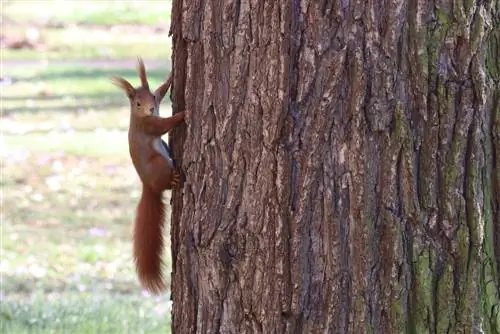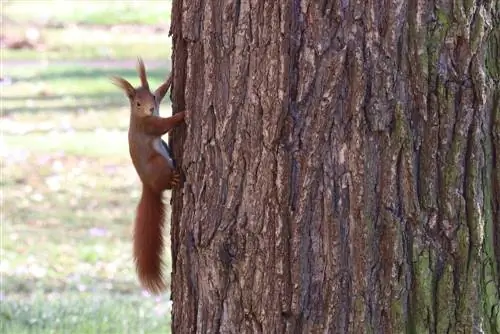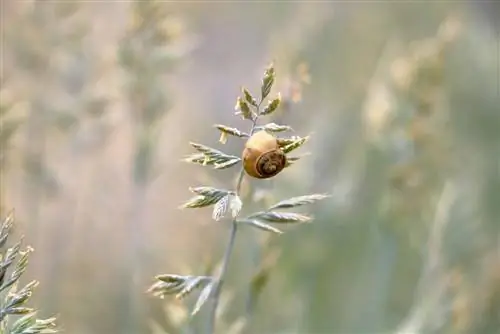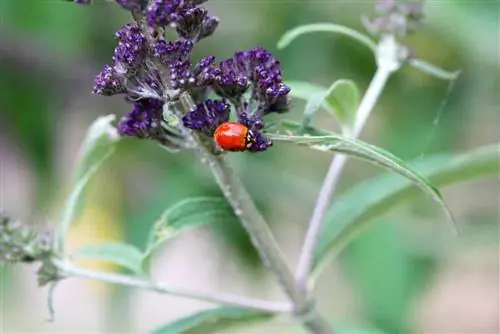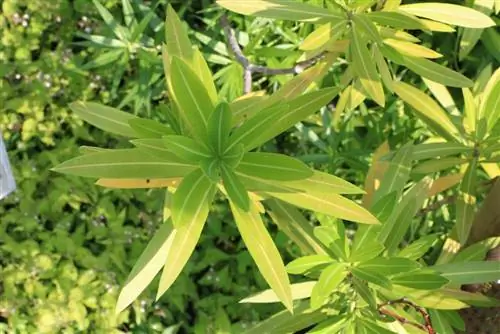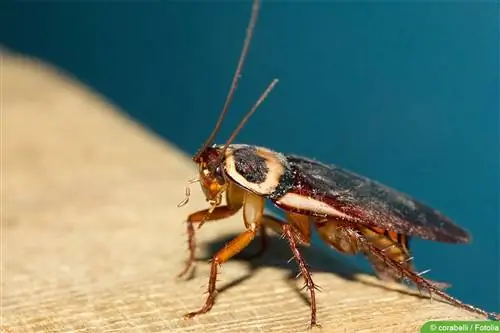- Author admin [email protected].
- Public 2023-12-17 03:39.
- Last modified 2025-01-24 12:45.
As outside temperatures fall, frost spreads and snow forms the winter landscape, the way of life of squirrels also changes. While they run and jump agilely through nature in spring and summer, they prepare for the cold winter season in autumn. To make winter easier for them, you should find out how squirrels (Sciurus vulgaris) spend the winter and how you can help them get through it well.
Winter Agility
The Sciurus vulgaris do not hibernate during the cold season and do not fall into hibernation, but only go through the cold months in hibernation. Only cold-blooded animals in the wild are affected by hibernation. Their body temperature drops to almost zero degrees Celsius so that they can adapt to the outside temperatures as best as possible. In this way they avoid the so-called cold death.
Since the squirrel, as the squirrel is also called, is not a cold-blooded animal species, it does not fall into hibernation without eating and being physically immobile. In contrast to cold-blooded animal species, numerous mammals and birds fall into hibernation. This is needed to also lower the body temperature, but only by a few degrees Celsius. Things are different with the tree foxes.
Because they maintain their body temperature in the cold season at almost the same level as in the other seasons, their body reacts differently and only needs hibernation to survive the winter. As the term hibernation suggests, these are periods of rest that differ from hibernation and hibernation due to short interruptions.
Body Functionality
When the time comes, the squirrel must go into hibernation in the wild in order to survive the cold outside temperatures.
This comes about because these animals significantly reduce their otherwise lively activity. As a result, despite a constant body temperature of around 37 degrees Celsius and a normal breathing rate, the metabolic function decreases and the heartbeat slows down.
This reduces energy requirements to a minimum, resulting in them needing less food. This means that they do not go completely without food, as is the case during hibernation or hibernation. That's why her body system forces her to eat every few days, even in winter.
When particularly cold winter days or icy storms accompany the day, the catkin often goes without food for days. The organs are protected from the cold by a thick, dense winter coat.
Nutrition
As an animal species that hibernates in the winter, the tree fox needs food every now and then to provide at least a little energy to the body.
The squirrel builds up its own supplies in the fall. They usually bury these deep, often up to 60 centimeters, in the ground or in hidden tree hollows.
Instinctively they usually know how large the supply they need to survive the winter season. It only becomes critical when the winter is particularly hard and long or the little squirrels can no longer find their supplies.
The latter happens more often, which is why the mortality rate of squirrels is highest in winter due to a lack of food. Since the body system continues to be active, albeit in a greatly reduced form, the body needs food to supply energy from outside. Only through food can it be ensured that the body system is maintained and that the functionality of the organs can continue throughout the winter.
Supplementary feeding
The squirrel usually finds its previously hidden and collected winter supplies. However, not always, which is why some people don't survive the winter. Especially when the ice, snow and cold drag on at this time of year, food supplies are not always enough. Your help is even more important by providing food for the Sciurus vulgaris.
You should distribute this daily near trees, bushes and shrubs, as these are the main places where the squirrel mainly hides its winter supplies and will go there in search of food. It is sufficient if you simply lay out the food at one point. The squirrels have an excellent sense of smell and will quickly find the trail to the new food source.
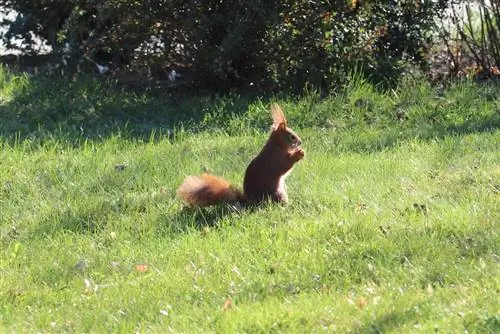
Once the food lying on the surface has been found, the tree fox will usually remember the feeding place and return whenever it needs food. It is therefore advisable to always lay out the food in the same place(s).
Suitable feedstuffs are:
- Pine cone seeds
- Fruits apples or pears
- Berries
- Nuts
- Sunflower and pumpkin seeds
- Flower buds
- Insects
- Mushrooms
When feeding supplements, make sure that the food is not s alted or otherwise seasoned. The small rodent's body cannot tolerate this and could potentially lead to life-threatening he alth problems.
Tip:
Do not remove the food if it is still there after days and has not been eaten. Depending on the weather conditions, the tree foxes may not leave their winter quarters for several days. It is all the more important for them that they can quickly find food afterwards.
City feeding
Especially in urban areas where there are no forests or many trees, the squirrels have a harder time finding optimal hiding places for their winter supplies. In addition, the food supply for stockpiling is significantly more limited. Here you should not neglect to provide food sources for the bushy fur animals. In your home garden, simply distribute the food over the ground at a safe distance from any sources of disturbance, such as main roads or a dog kennel.
On the balcony you can optimally distribute nuts or chopped fruit on the soil in balcony plant boxes between winter plants. You can also put the food in a bird feeder. Here the squirrel finds its food easily, but usually to the detriment of the birds, who shy away from the squirrel.
You can also help these animals with food if you take a handful with you on your Sunday winter walk in the park and leave it out there.
Tip:
Especially in the city, place an additional bowl of water next to the food you have spread out. Where there is a lot of asph alt and straight plains, there are significantly fewer puddles than in the countryside and the water supply is usually limited.
Winter quarters
As winter quarters, the squirrel builds between two and eight nests, so-called kobels, in early autumn. The nests are usually built at a height of at least six meters. To build, they use fine twigs, leaves and pine needles as a base, while they decorate the interior with feathers, moss and/or grass. They often make use of old bird nests or use abandoned caves that were previously inhabited by woodpeckers.
They shape their nests as a ball with a hole pointing upwards and an inner bulge or cavity in which they can lie down. They have an inner diameter between 15 centimeters and 20 centimeters. Unlike bird nests, the squirrel nest also has a loophole in the lower area because it enters the nest from below. The winter quarters are almost waterproof and offer good protection from the cold thanks to their close-meshed structure.
While one nest is used for hibernation, which usually lasts for days, a second is needed for daytime residence during breaks in rest. All other nests are built for the purpose of escape. If a used nest is contaminated with parasites or something similar, if a danger has unexpectedly become apparent in the area or if a nest has been damaged, the squirrels always have several spare nests in case of an emergency. A kobel will also be built for any young offspring to protect them.
This species needs between three and five days to build a kobel. The squirrel is a solitary animal, which is why it generally inhabits a nest alone.
Nest building aid
Where forests and large stands of trees are rare, people are making it increasingly difficult for squirrels to build their nests and overwinter in their gardens. This is due to the fact that many hobby gardeners cut back their trees, shrubs and hedges heavily in autumn so that they can sprout again vigorously next spring. In this way, they are increasingly depriving the animals of their winter habitat, which can become a problem for the rodents, especially in the city or in densely built-up residential areas.
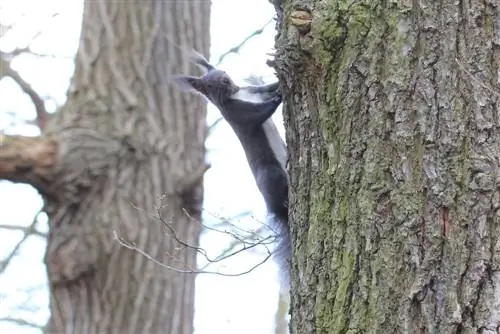
It is often forgotten that the oak cats are an important factor for nature. Since they almost always forget some storage locations that also contain seeds, they often don't have them the next spring and thus contribute to nature.
For this reason, you should note the following in consideration of the tree foxes:
- Do not cut tall trees below six meters
- Leave at least one or two dense branches when pruning trees, hedges or shrubs
- Before each pruning, check plants for possible nests
- No pruning of branches with nests in them
- In the fall, do not remove all needles or leaves to provide material for nest building
- Do not throw away pine cones - they serve as a food source
- If necessary, carefully reposition old nests in a tall tree
- Walk and hazelnut trees attract squirrels
Conclusion
Squirrels only hibernate during the cold winter period, which they only interrupt every two to three days to eat, depending on the cold. As the cold continues to increase and winters become longer and longer, these animals often need the support of humans. With just a little effort you can make winter easier for Sciurus vulgaris, contribute to their survival and do good for nature.

